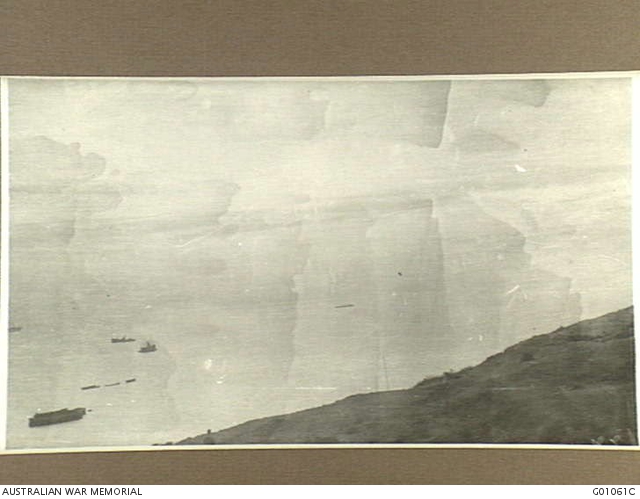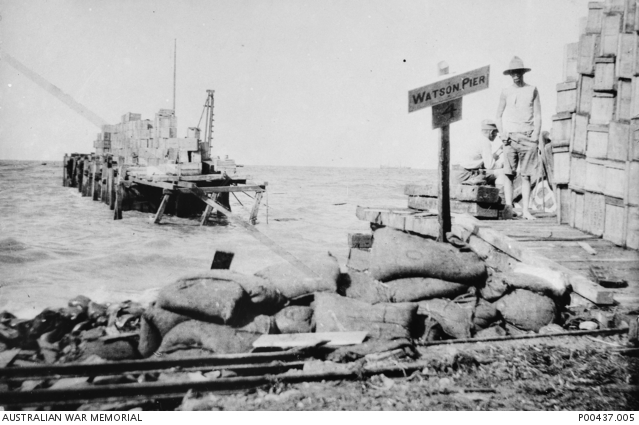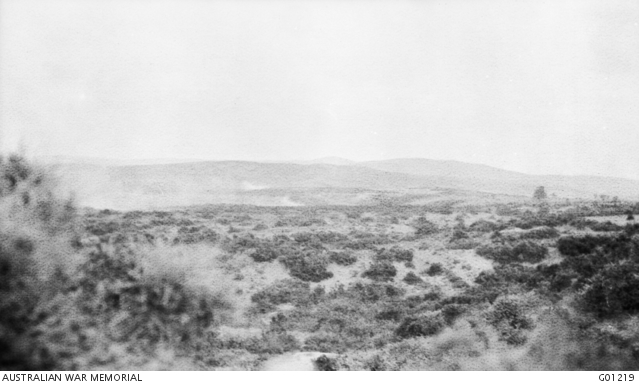25 April 1915
In the early hours of 25 April, the AE2 Australian submarine is ordered to penetrate the Dardanelles Strait passage and 'run amok' in the Sea of Marmara. It was the first submarine to do so and quickly engaged a Turkish torpedo boat to make its presence known. This made it the first Australian unit to engage in the battle of Gallipoli. The AE2 achieves its purpose of distracting Turkish Naval vessels from the main effort in the peninsula and news of its success increases the morale of those in charge of the beach landings that were about to be undertaken.
At 4:30am the 3rd Australian Brigade lands at Ari Burnu Point to act as the covering force for the remainder of the ANZACs set to land further south toward Gaba Tepe. Simultaneously, the British 29th Division lands at Cape Helles on the southern tip of the Gallipoli Peninsula. French forces launch a feint on Kum Kale on the Dardanelles southern shore.

Image 1: Map of the Allied invasion of the Gallipoli Peninsula in April 1915.
The remainder of the ANZACs are landed in what would become ANZAC Cove throughout the day, a couple of kilometres further north than originally intended. They suffer significant resistance and persistent counter attacks from the Turkish forces. By day's end the ANZACs hold a narrow strip of the peninsula just 2km long and 1km deep at its widest point. The British are contained within two small pockets in the south.
26 April 1915
More than 1700 casualties are evacuated from ANZAC Cove.
27 April 1915
Turkish counter-attacks aimed at driving the ANZACs back into the sea fail. French forces evacuate Kum Kale and reinforce the British right flank at Cape Helles.
The destroyers Chelme and Colner took turns at shelling the Turks at dusk each evening during the Gallipoli campaign.

Image 2: Every evening about sundown a destroyer, generally Chelmer or Colne, used to move close in to left flank and shell Turks at No. 3 Post and Table Top, 27 July 1915.
28 April 1915
Battalions of the Royal Navy Division, a Navy unit that fought on land as infantry, begin relief of Australian units.
29 April 1915
The first casualties of Gallipoli reach the No. 1 Australian General Hospital in Heliopolis, Egypt.
The AE2 Submarine is sunk in the Sea of Marmara and the crew are captured. They will spend the remainder of the war as POWs.
Following the heroic acts at Gallipoli, His Majesty, King George V sends a telegram to Australia stating, “I heartily congratulate you upon the splendid conduct and bravery displayed by the Australian troops in the operations at the Dardanelles, who have indeed proved themselves worthy sons of the Empire.”
The first news of the Gallipoli landings is released to the Australian public by the Prime Minister, Andrew Fisher. It offers little detail, reading “Some days ago the Australian War Expeditionary Forces were transferred from Egypt to the Dardanelles. They have since landed.”
03 May 1915
The first casualty lists are released to in Australia in newspapers around the country.
May 1915
ANZAC Cove is persistently shelled from a position behind Turkish lines.
The village of Krithia is attacked by the Commonwealth forces multiple times, but they fail to break through Turkish defences.
The first burials of the ANZAC dead were conducted, more than a fortnight after the landings.
The 1st Australian Light Horse Brigade arrives mid-month to be used as dismounted infantry reinforcements.
Major General William Bridges, Commander of the 1st Australian Division is shot by a Turkish sniper and dies on the hospital ship Gascon on his way to Egypt.
The sinking of the battleship HMS Triumph on 25 May 1915 by German submarine U21 gave the ANZACs a sudden sense of abandonment. Until this time they had settled into the comfort of having a familiar figure of power and influence over the battle at their rear on the horizon. The sinking left an empty void in the sea. This would not be the last sinking caused by Submarine U21, with HMS Majestic sunk just two days later.
June 1915
The 1st Australian Field Bakery moves from Lemnos to Imbros, the closest major island to the Peninsula, to shorten supply lines for the rations sent to Gallipoli on a trawler boat each day.
Watson’s Pier is constructed in ANZAC Cove by the 2nd Australian Field Company, Royal Australian Engineers. This enables easier landing of stores and equipment into ANZAC Cove.

Image 3: On 17 November 1915, two soldiers stand on the shore end of Watson’s Pier extensively damaged after a severe storm. Forty feet of trestle construction was torn away from the pier as a lighter broke through it during the storm.
July 1915
Dysentery becomes widespread within the trenches. Cholera inoculations begin within ANZAC Cove.
Colonel Neville Howse, Assistant Director of the AIF Medical Services conducts an assessment on the health of the men in the 1st Division prior to the planned August offensive. His report identifies that up to 30% of the men are not fit for the operation and the rest are certainly not able to sustain prolonged operations.
August 1915 – The August Offensive
An extra 20,000 soldiers from the British 13th Division are quietly moved ashore at ANZAC Cove in preparation for the proposed ‘August Offensive'.
On the 6th of August the British 29th Division conducts an attack at Helles aimed to hold up Turkish reinforcements from the main thrust of the August offensive. The 1st Australian Division attacks the Turkish trenches at Lone Pine, successfully breaking into their defensive line and repelling numerous Turkish counter attacks. The New Zealand Mounted Rifles attacks up the valleys leading to Sari Bair Range. Three columns of infantry then follow to attack the heights. The British force then begins landing at Suvla Bay in the north.
Over the days that followed the Allied Forces make no significant progress with advances met by fierce Turkish resistance and persistent counter attacks.
Seven Victoria Cross medals are later awarded to AIF soldiers following the defence of Lone Pine.
General Hamilton visits Suvla Bay to encourage the British troops to advance. Turkish reinforcements arrive and push British forces out of of Tekke Tepe in the north.
Lieutenant Colonel Mustafa Kemal (later known as Ataturk) leads a Turkish counterattack against the British forces holding the peak of Chunuk Bair uphill from ANZAC Cove. This peak had previously been seized by New Zealand forces.
General Hamilton informs Lord Kitchener that the offensive has failed on 17 August 1915. Considerable casualties have been sustained on both sides, with the dominating terrain held by the Turkish forces almost impossible to seize and retain. General Hamilton requests 45,000 reinforcements with some battalions having lost around half of their forces through battle casualties and non-battle illnesses such as dysentery. He requests an additional 50,000 troops on top of the 45,000 to have sufficient forces to enable future offensives at Gallipoli.
19 August 1915
The first of the Australian 2nd Division arrive as reinforcements.
21 August 1915
Australian and New Zealand troops attempt to take Hill 60 while British troops attempt to take Scimitar Hill. Heavy Allied casualties meant that these would be the final battles at Gallipoli.

Image 4: On 27 August 1915, smoke may be seen rising from the burning scrub on the seaward slopes of Hill 60 and on Kaiajik Dere. These fires were started by bursting shells and some of the wounded were burnt.
03 September 1915
Major General William Throsby Bridges is buried on the grounds of the Royal Military College Duntroon, Canberra. He was to be the only Australian soldier who died overseas during the World Wars that would be repatriated to Australia for burial.









